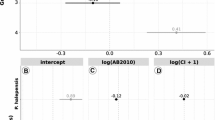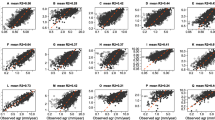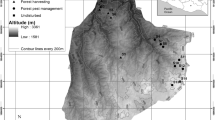Abstract
Key message
Our modelling approach shows the predominance of the facilitative over the competition effects in controlling the regeneration of the studied species, thus pointing out to intra- and inter-specific coexistence mechanisms.
Abstract
Natural regeneration is a main issue in the management of continental Mediterranean forests. Ensuring natural forest regeneration is therefore vital for preserving ecosystem function under climate warming and increased frequency and intensity of extreme droughts. In this study, we evaluated intraspecific and inter-specific relationships between saplings and adult trees in mixed Pinus pinea-Quercus ilex-Juniperus stands in the Spanish Northern Plateau. Data were gathered from five 50 m × 60 m plots that covered different stand densities. Adult trees, saplings, and stumps were positioned, and height and diameter were measured. We developed a patch model to predict the probability of occurrence and abundance of saplings of the three species in 2.5 m × 2.5 m patches using a zero-inflated model. We considered as predictive variables abundance of adult trees, stumps, and saplings of each species, both in a patch and in its adjacent patches. Saplings of the three species showed a cluster pattern. The abundance of saplings of the three species was positively related with the current or past presence of their conspecific adult trees. The presence of adult trees of Pinus pinea plays a main role in both Quercus ilex and Juniperus dissemination. Our modelling approach shows the predominance of the facilitative effects over the competition effects in controlling the regeneration of the three species, pointing out to intra- and inter-specific coexistence mechanisms. The simulations suggested that to perpetuate the mixture, it is necessary to apply intense release cuttings in Pinus pinea trees once seedlings have been successfully established.






Similar content being viewed by others
Availability of data and materials
All data and materials support the published claims and comply with field standards. The datasets generated during and/or analysed during the current study are available from the corresponding author on reasonable request.
Code availability
Not applicable.
References
Our results
Barbeta A, Peñuelas J (2016) Sequence of plant responses to droughts of different timescales: lessons from holm oak (Quercus ilex) forests. Plant Ecol Divers 9(4):321–338. https://doi.org/10.1080/17550874.2016.1212288
Blanco JA, Welham C, Kimmins JPH, Seely B, Mailly D (2009) Guidelines for modeling natural regeneration in boreal forests. For Chron 85(3):427–439. https://doi.org/10.5558/tfc85427-3
Bugmann H (2001) A Review of Forest Gap Models. Clim Change 51:259–305. https://doi.org/10.1023/A:1012525626267
Calama R, Pardos M, Mayoral C et al (2014) Regeneración de Pinus pinea y Juniperus oxycedrus en masas mixtas piñonero–encina–enebro en los valles del Tiétar y del Albeche (sistema central, España). Cuad Soc Esp Cienc for 40:75–86
Calama R, Puértolas J, Manso R, Pardos M (2015) Defining the optimal regeneration niche for Pinus pinea L. through physiology-based models for seedling survival and carbon assimilation. Trees 29(6):1761–1771. https://doi.org/10.1007/s00468-015-1257-5
Calama R, Manso R, Lucas-Borja ME et al (2017) Natural regeneration in Iberian pines. A review of dynamic processes and proposals for management. For Syst. https://doi.org/10.5424/fs/2017262-11255
Calama R, Madrigal G, Pardos M, Gordo J, Gonzalez A (2020). Esquema de Selvicultura para masas mixtas de Pinus pinea, Juniperus thurifera y Quercus sp. Technical Report INIA-JCyL. https://sites.google.com/site/regeneracionnatural/proyecto-rta2013-00011-c02-00/resultados/esquemas-de-selvicultura-actual
Calama R, de Dios-García J, del Río M, Madrigal G, Gordo FJ, Pardos M (2021) Mixture mitigates the effect of climate change on the provision of relevant ecosystem services in managed Pinus pinea L. forests. For Ecol Manag. https://doi.org/10.1016/j.foreco.2020.118782
Carnicer J, Coll M, Pons X et al (2014) Large-scale recruitment limitation in Mediterranean pines: the role of Quercus ilex and forest successional advance as key regional drivers. Glob Ecol Biogeogr 23:371–384. https://doi.org/10.1111/geb.12111
Clark JS, Macklin E, Wood L (1998) Stages and spatial scales of recruitment limitation in southern Appalachian forests. Ecol Monogr 68:213–235. https://doi.org/10.1890/0012-9615(1998)068[0213:SASSOR]2.0.CO;2
de Dios-García J, Manso R, Calama R, Fortin M, Pardos M (2018) A new multifactorial approach for studying intra-annual secondary growth dynamics in Mediterranean mixed forests: integrating biotic and abiotic interactions. Can J For Res 48(4):333–344. https://doi.org/10.1139/cjfr-2017-0139
de Soto L, Olano JM, Rozas V, de la Cruz M (2010) Release of Juniperus thurifera woodlands from herbivore-mediated arrested succession in Spain. App Veg Sci 13:15–25. https://doi.org/10.1111/j.1654-109X.2009.01045.x
Escribano-Ávila G, Sanz-Pérez V, Pías B et al (2012) Colonization of abandoned land by Juniperus thurifera is mediated by the interaction of a diverse dispersal assemblage and environmental heterogeneity. PLoS ONE. https://doi.org/10.1371/journal.pone.0046993
Escribano-Ávila G, Pías B, Sanz-Pérez V et al (2013) Spanish juniper gain expansion opportunities by counting on a functionally diverse dispersal assemblage community. Ecol Evol 3(11):3751–3763. https://doi.org/10.1002/ece3.753
Esler KJ, Cowling RM (1993) Edaphic factors and competition as determinants of pattern in South African karoo vegetation. S Afr J Bot 59(3):287–295. https://doi.org/10.1016/S0254-6299(16)30730-X
Espelta JM, Riba M, Retana J (1995) Patterns of seedling recruitment in West-Mediterranean Quercus ilex forests influenced by canopy development. J Veg Sci 6:465–472. https://doi.org/10.2307/3236344
Forrester DI, Bauhus J, Cowie AL, Vanclay JK (2006) Mixed-species plantations of Eucalyptus with nitrogen-fixing trees: a review. For Ecol Manag 233:211–230. https://doi.org/10.1016/j.foreco.2006.05.012
Fortin M, de Blois J (2007) Modeling tree recruitment with zero-inflated models: the example of hardwood stands in southern Quebec. Canada for Sci 53(4):529–539. https://doi.org/10.1093/forestscience/53.4.529
García-Güemes C, Calama R (2015) La práctica de la selvicultura para la adaptación al cambio climático. En Herrero, A., Zavala MA. Los Bosques y la Biodiversidad frente al Cambio Climático: Impactos, Vulnerabilidad y Adaptación en España, Chap 46, MAGRAMA, pp 501–512
Gimeno TE, Camarero JJ, Granda E, Pía B, Valladares F (2012) Enhanced growth of Juniperus thurifera under a warmer climate is explained by a positive carbon gain under cold and drought. Tree Physiol 32:326–336. https://doi.org/10.1093/treephys/tps011
Gómez-Aparicio L (2008) Spatial patterns of recruitment in Mediterranean plant species: linking the fate of seeds, seedlings and saplings in heterogeneous landscapes at different scales. J Ecol 96:1128–1140. https://doi.org/10.1111/j.1365-2745.2008.01431.x
Gordo J, Calama R, Pardos M, Bravo F, Montero G (eds.) (2012) La regeneración natural de Pinus pinea L. y Pinus pinaster Ait. en los arenales de la Mesta Castellana. IUGFS, Valladolid
Granda E, Escudero A, de la Cruz M, Valladares F (2012) Juvenile–adult tree associations in a continental Mediterranean ecosystem: no evidence for sustained and general facilitation at increased aridity. J Veg Sci 23:164–175. https://doi.org/10.1111/j.1654-1103.2011.01343.x
Granda E, Escudero A, Valladares F (2014) More than just drought: complexity of recruitment patterns in Mediterranean forests. Oecologia 176:997–1007. https://doi.org/10.1007/s00442-014-3064-x
Grassi G, Minotta G, Tonon G, Bagnaresi U (2004) Dynamics of Norway spruce and silver fir natural regeneration in a mixed stand under uneven-aged management. Can J For Res 34(1):141–149. https://doi.org/10.1139/x03-197
Kukowski KR, Schwinning S, Schwartz BF (2013) Hydraulic responses to extreme drought conditions in three co-dominant tree species in shallow soil over bedrock. Oecologia 171(4):819–830. https://doi.org/10.1007/s00442-012-2466-x
Lambert D (1992) Zero-inflated poisson regression, with an application to defects in manufacturing. Technometrics 34(1):1–14. https://doi.org/10.1080/00401706.1992.10485228
Ledo A, Cañellas I, Barbeito I et al (2014) Species coexistence in a mixed Mediterranean pine forest: spatio-temporal variability in trade-offs between facilitation and competition. For Ecol Manag 322:89–97. https://doi.org/10.1016/j.foreco.2014.02.038
Ledo A, Cayuela L, Manso R, Condés S (2015) Recruitment patterns and potential mechanisms of community assembly in an Andean cloud forest. J Veg Sci 26(5):876–888. https://doi.org/10.1111/jvs.12287
Lepage PT, Canham CD, Coates KD, Bartemucci P (2000) Seed abundance versus substrate 725 limitation of seedling recruitment in northern temperate forests of British Columbia. Can J For Res 30(726):415–427. https://doi.org/10.1139/x99-223
Lindner M, Calama R (2013) Climate change and the need for adaptation in Mediterranean forests. In: Lucas-Borja ME (ed) Mediterranean forest management under the new context of climate change. Nova Science Publishers, New York
Lookingbill TR, Zavala MA (2000) Spatial pattern of Quercus ilex and Quercus pubescens recruitment in Pinus halepensis dominated woodlands. J Veg Sci 11:607–612. https://doi.org/10.2307/3246590
Manso R, Pardos M, Keyes CR, Calama R (2012) Modelling the spatio-temporal pattern of primary dispersal in stone pine (Pinus pinea L.) stands in the Northern Plateau (Spain). Ecol Model 226:11–21. https://doi.org/10.1016/j.ecolmodel.2011.11.028
Manso R, Calama R, Madrigal G, Pardos M (2013) A silviculture-oriented spatio-temporal model for germination in Pinus pinea L. in the Spanish Northern Plateau based on a direct seeding experiment. Eur J For Res 132(5–6):969–982. https://doi.org/10.1007/s10342-013-0724-z
Manso R, Pardos M, Calama R (2014a) Climatic factors control rodent seed predation in Pinus pinea L. stands in Central Spain. Ann for Sci 71(8):873–883. https://doi.org/10.1007/s13595-014-0396-y
Manso R, Pukkala T, Pardos M, Miina J, Calama R (2014b) Modelling Pinus pinea forest management to attain natural regeneration under present and future climatic scenarios. Can J For Res 44(3):250–262. https://doi.org/10.1139/cjfr-2013-0179
Manso R, Calama R, Pardos M, Fortin M (2018) A maximum likelihood estimator for left-truncated lifetimes based on probabilistic prior information about time of occurrence. J Appl Stat 45(12):2107–2127. https://doi.org/10.1080/02664763.2017.1410527
Manso R, Ligot G, Fortin M (2019) A recruitment model for beech–oak pure and mixed stands in Belgium. Forestry 93(1). https://doi.org/10.1093/foresj/cpz056
Marañón T, Camarero JJ, Castro J et al (2004) Heterogeneidad ambiental y nicho de regeneración. In: Valladares F (ed) Ecología del bosque mediterráneo en un mundo cambiante. Ministerio de Medio Ambiente, EGRAF, S. A., Madrid. ISBN: 84-8014-552-8: 69-99
Martin GL, Ek AR, Monserud RA (1977) Control of plot edge bias in forest stand growth simulation models. Can J For Res. https://doi.org/10.1139/x77-014
Martín-Baroja L, Pérez-Camacho L, Villar-Salvador P et al (2019) Massive and effective acorn dispersal into agroforestry systems by an overlooked vector, the Eurasian magpie (Pica pica). Ecosphere. https://doi.org/10.1002/ecs2.2989
Mayoral M, Pardos M, Sánchez-González M et al (2016) Ecological implications of different water use strategies in three coexisting mediterranean tree species. For Ecol Manag 382:76–87. https://doi.org/10.1016/j.foreco.2016.10.002
Montesinos D, Verdú M, García-Fayos P (2007) Moms are better nurses than dads: gender biased self-facilitation in a dioecious Juniperus tree. J Veg Sci 18:271–280. https://doi.org/10.1111/j.1654-1103.2007.tb02538.x
Nyland R (2002) Silviculture: concepts and applications, 2nd edn. The McGraw-Hill Companies, New York
Pardos M, Ruiz del Castillo J, Cañellas I, Montero G (2005) Ecophysiology of natural regeneration of forest stands in Spain. Investig Agrar Sist Recur for 14(3):434–445
Poorter L, Lianes E, Moreno-de las Heras M, Zavala MA (2012) Architecture of Iberian canopy tree species in relation to wood density, shade tolerance and climate. Plant Ecol 213:707–722. https://doi.org/10.1007/s11258-012-0032-6
Price DT, Zimmermann NE, van de Meer PJ et al (2001) Regeneration in gap models: priority issues for studying forest responses to climate change. Clim Change 51:475–508. https://doi.org/10.1023/A:1012579107129
Rabasa SG, Granda E, Benavides R et al (2013) Disparity in elevational shifts of European trees in response to recent climate warming. Glob Change Biol 19:2490–2499. https://doi.org/10.1111/gcb.12220
Retana J, Espelta JM, Gracia M, Riba M (1999) Seedling recruitment. In: Rodà F, Retana J, Gracia C, Bellot J (eds) Ecology of editerranean evergreen oak forests. Springer, Berlin, pp 89–103
Rodríguez-Calcerrada J, Pérez-Ramos IM, Ourcival JM et al (2011) Is selective thinning an adequate practice for adapting Quercus ilex coppices to climate change? Ann for Sci 68:575–585. https://doi.org/10.1007/s13595-011-0050-x
Smith D, Larson B, Kelty J, Ashton P (1996) The practice of silviculture: applied forest ecology. John Wiley & Sons Inc, Hoboken
Urli M, Delzon S, Eyermann A et al (2013) Inferring shifts in tree species distribution using asymmetric distribution curves: a case study in the Iberian mountains. J Veg Sci. https://doi.org/10.1111/jvs.12079
Vergarechea M, Calama R, Fortin M, del Río M (2019) Climate-mediated regeneration occurrence in Mediterranean pine forests: a modeling approach. For Ecol Manag 446:10–19. https://doi.org/10.1016/j.foreco.2019.05.023
Yang Y, Monserud RA, Huang S (2004) An evaluation of diagnostic tests and their roles in validating forest biometric models. Can J For Res 34:619–629. https://doi.org/10.1139/X03-230
Zavala MA, Zea E (2004) Mechanisms maintaining biodiversity in Mediterranean pine-oak forests: insights from a spatial simulation model. Plant Ecol 171:197–207. https://doi.org/10.1023/B:VEGE.0000029387.15947.b7
Zavala MA, Espelta JM, Caspersen J, Retana J (2011) Interspecific differences in sapling performance with respect to light and aridity gradients in Mediterranean pine–oak forests: implications for species coexistence. Can J For Res 41:1432–1444. https://doi.org/10.1139/X11-050
Acknowledgements
The authors thank the Forest Service at Valladolid for their support in the installation and maintenance of the plots. The study was supported by the national project AGL2017-83828.
Funding
The study was supported by the national project AGL2017-83828.
Author information
Authors and Affiliations
Corresponding author
Ethics declarations
Conflict of interest
The authors declare that they have no known competing financial interests or personal relationships that could have appeared to influence the work reported in this paper.
Ethics approval
Not applicable.
Consent to participate
All authors obtained consent to participate.
Consent for publication
All listed authors have approved the manuscript before submission.
Additional information
Communicated by A. Inoue.
Publisher's Note
Springer Nature remains neutral with regard to jurisdictional claims in published maps and institutional affiliations.
Supplementary Information
Below is the link to the electronic supplementary material.
Rights and permissions
About this article
Cite this article
Pardos, M., Madrigal, G., de Dios-García, J. et al. Sapling recruitment in mixed stands in the Northern Plateau of Spain: a patch model approach. Trees 35, 2043–2058 (2021). https://doi.org/10.1007/s00468-021-02171-2
Received:
Accepted:
Published:
Issue Date:
DOI: https://doi.org/10.1007/s00468-021-02171-2




